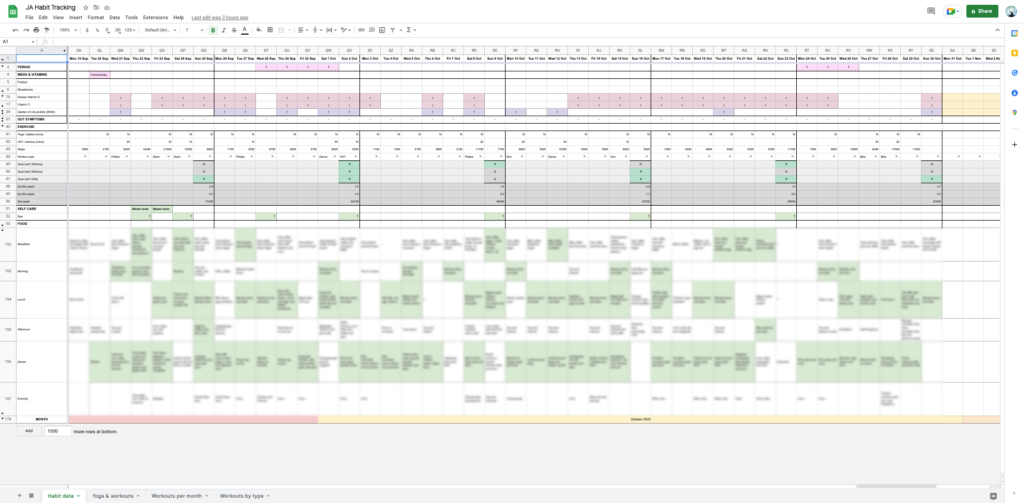This is how I use t-shirt sizing, habit stacking and data tracking to make my habits stick.

Check out this video (12min) for the full run through:
The short version
- T-shirt sizing can help to set a minimum, medium and maximum version of your habit — so there’s always some version you can do
- Habit stacking can help to associate the new habit with something you already do — rather than trying to develop a new routine from scratch
- Habit tracking can help to motivate you — by seeing the data, and noticing when things are improving over time
The long version
I am a super nerd when it comes to my habits and systems. I’ve read all the books and I’ve tried all the things and found something that works pretty well for me, which is the idea of “t-shirt sizing” — that is having a small version, a medium version and a large version of what you could do. I found really helpful because we are not robots, we are human beings. We trick ourselves into thinking we’re going to have 100% energy every day, and then —”big surprise”— we get sick or just don’t feel like it. And because that is totally normal, I really liked the idea of this system, because it allows for those ebbs and flows.
So what does this method look like? Here are a few examples of how I apply it:
1. My daily blog contribution
The smallest version of a thing I could do each day is come up with a post idea. Literally go into the Notes file on my iPhone and jot down anything. I don’t even have to write a post about that idea in the future, it’s just having the idea and writing it down. That’s the absolute bare minimum: come up with one idea, however terrible, put it in the thing, and I’m done for the day – that’s a contribution.
The medium version is taking one of those post ideas (or a new one) and turning it into an outline. So jotting down:
- what’s going to be the point of this post / what someone’s going to get out of it
- what’s going to be the start, middle, end
- any references
Basically what are the bones of what this post could be about.
Then if I happen to have a lot of time, or a lot of energy, or a lot of like brain space to actually write a post, that’s my large “t-shirt size”, ie. the large version of the habit that I could choose to do. To be honest, I’ll probably only do that once a week, and that’s when I’ll often film a video first, and write an accompanying post second (like this one!).
2. My daily step count
- I have an average goal I want to hit of 7,500 steps per day, but my minimum goal is 4,000 steps per day — so even on the days where I’m not feeling healthy and vibrant, or I need to rest, I still have that minimum 4,000 steps to shoot for, even if that’s just a few laps of the house or backyard while doing other things.
- So then 7,500 steps is the medium size: my goldilocks daily goal.
- Then 10,000 steps in a day is for when I’m feeling really active.
3. My daily yoga stretching
- I do 10 minutes of stretching as the minimum each day.
- The next level up is 30 minutes.
- Then the top level is 60 minutes.
Converting daily to weekly goals
After using this approach for a while, I adjusted from a “daily habit system” to a “weekly habit system”.
In the past I had a 10 minute per day goal for doing yoga, but that doesn’t allow for any days off, even though I know there are going to be days when I don’t feel like doing it. So I changed to a 60 minute weekly stretching goal, eg:
- 10 minutes x 6 days then have a day off; or
- 10 minutes x 4 days, plus 20 minutes x 1 day, then have two days off
For my weekly step goal, I now aim for 50,000 steps as a minimum over the course of each week. If I’ve done a couple of 20,000 step days, I can have a few days respite. And I have a weekly workout goal of 60 minutes per week – which might be 3x 20 minute workouts, or just one 60 minute workout (I went to a ‘No lights, No lycra’ dance session the other day and it goes for a whole hour, so that was my minimum done for the week!).
With such a flexible system it means I can pick and choose how to achieve the goal without ‘failing’ – you have ‘weekly buckets’ which you can fill up at a varied pace, depending on when you have energy through the week.
Habit stacking
Habit stacking is based on the principle that it’s easier to attach a new habit to something you already do, rather than trying to start fresh – with credit to James Clear for explaining this in his book, Atomic Habits (a must read for any other habit nerds out there!)
So how does habit stacking work for me? Here are my examples:
- Daily stretching: I do this straight after I wake up, sometimes I don’t even change out of my pyjamas! I just wake up, and stretch. No thinking about it, I just do it.
- Daily walks (towards my step count): I pair these walks with listening to a podcast, either in the morning before work, on my lunch break, or in the evening after work. There’s always something I want to listen to, so if I’m walking at the same time I get a 2-for-1 special, plus I can use the podcast as a guide to how long I’ve been walking (an hour of walking is about 4,000 steps).
- Working on this blog (!): this one is new —well, not the blog, but the more consistent ‘habit’— so I’m still figuring out where it fits into my routine but it’s something I look to do on my commute to the office if it’s not a work from home day, otherwise in the evening after I finish work. Some days I have zero brain space after work, so I come up with a post idea and that’s enough. Other days I might draft an outline. And on high energy days I’ll write a draft, or record a video.
Habit tracking
Okay, so this one is kind of Next Level but I have a habit tracking spreadsheet in Google Sheets. I originally started this one to monitor some funky gut issues I was having, along with the vitamins and meds I was taking (to see if/how these were affecting my symptoms), but over time I expanded it to include my daily steps, stretching, and workouts, as well as when I got my period, what I was eating, and eventually even self-care stuff too, like ‘how many spas did I take this week?!’.
This is what my habit tracking spreadsheet looks like:

I’ve tried various habit tracking apps over the years, but I’ve landed on this ‘lo-fi’ approach because I want to be able to keep customising it over time. I can easily add new rows or sections, and hide things that aren’t relevant — until they become relevant again.
I also started using a ‘green background’ tagging system for the food entries, based on my own instinct around what deserves a green tag (generally that’s anything made mostly from fruit, vegetable and whole food content, as opposed to carbs or processed food).
By tracking all this data, I can look for patterns based on what I had actually done, rather than relying on my memory of things. And it’s motivational! The data helps me make better decisions about what to eat, and encourages me to get proper movement in.
The best part of the spreadsheet system is being about to chart things visually – and being able to see if your steps are trending upwards, for example.
Here’s a Google Sheets template you can duplicate to use for yourself.
Recap
So between the “t-shirt sizing” approach (to select a small, medium or large version of the habit to do depending on your energy), the habit stacking (attaching the new habit to an old one), and the habit tracking (to motivate with data) – I’ve found the system works! It usually feels achievable, and even when I don’t meet the daily or weekly goals, I feel like I’ve been setup with the best chance for success, and to do more than I would have with less realistic goals (like 10,000 steps every single day, no thank you!).
Check out some of our other health-related posts to see what else we use, and experiments we’ve tried.




Hey Jess could you share a copy of your sheet? Thanks and good luck.
Sure thing! I\’ve just setup a Google Sheets template, including a demo for how to use it yourself — feel free to duplicate that doc and have a play around. It\’s not quite as complex as the version I use, but should be enough to get you started ☺️